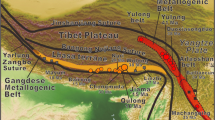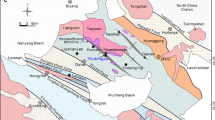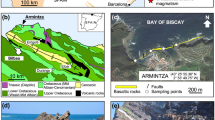Abstract
The island of Curaçao in the southern Caribbean Sea is composed mainly of a thick sequence (>5 km) of pillow lavas, grading upwards from picrites at the base of the exposed section, to basalts nearer the top. Modelling suggests that picrites are related to the basalts by fractional crystallisation. Initial radiogenic isotope ratios of the picrites have a restricted compositional range: ɛNd=+6.1 to +6.6, 87Sr/86Sr=0.70296–0.70319; whereas the basalts display a wider range of compositions: ɛNd=+6.6 to +7.6, 87Sr/86Sr=0.70321–0.70671. This variation in isotope ratios between basalts and picrites may be due to the assimilation of altered oceanic crust (or possibly partial melts of such crust) by a picritic magma along with fractional crystallisation. The relatively narrow range of Nd and Pb isotopic compositions in the Curaçao lavas suggests either that the source region was homogeneous, or that melts from a heterogeneous mantle source were well mixed before eruption. Chondritic to slightly light rare earth element enriched patterns, combined with long-term light rare earth element depletion (positive ɛNd), suggest that the lavas were formed by polybaric melting of spinel lherzolite, with small a contribution from garnet lherzolite melts. High-MgO lavas, the absence of a subduction related chemistry, and the chemical similarity to other oceanic plateaux, suggest a mantle plume origin for the Curaçao lava succession. The Curaçao volcanic sequence is part of an oceanic plateau formed at about 88–90 Ma, fragments of which are dispersed around the Caribbean as well as being obducted onto the western margin of Colombia and Ecuador. The occurrence of high-Mg lavas throughout this Cretaceous Caribbean–Colombian igneous province requires anomalously hot mantle (>200° C hotter than ambient upper mantle) over a large part of a putative plume head, which is inconsistent with some mantle plume models.
Similar content being viewed by others
Author information
Authors and Affiliations
Additional information
Received: 1 September 1995/Accepted: 5 February 1996
Rights and permissions
About this article
Cite this article
Kerr, A., Tarney, J., Marriner, G. et al. The geochemistry and petrogenesis of the late-Cretaceous picrites and basalts of Curaçao, Netherlands Antilles: a remnant of an oceanic plateau. Contrib Mineral Petrol 124, 29–43 (1996). https://doi.org/10.1007/s004100050171
Issue Date:
DOI: https://doi.org/10.1007/s004100050171




